The best Ichimoku strategy is a technical indicator system used to assess the markets. This unique strategy provides trading signals of a different quality. Forex trading involves substantial risk of loss. Although, with Ichimoku cloud trading, those losses are contained and kept small.
The Ichimoku system is a Japanese charting method and a technical analysis method. Our team at Trading Strategy Guides mastered the method over a long period of time.
The Ichimoku indicator was published in 1969 by a reporter, Ichimoku Kinkou Hyo, in Japan. This candlestick trading technique has stood the test of time.
The name Ichimoku tells a lot about the trading system, or at least it gives a description of the system.
Ichimoku = “One look, glance”.
Kinkou = “Balance, equilibrium”.
Hyo = “Chart, Graph”.
Swing Trading ReportGet Our Free Swing Trading Strategy
Get Our Free Swing Trading Report Today!
- Entry Points
- Exit Points
- Risk Managament
- Time Saving Tips
Ichimoku cloud trading attempts to identify a probable direction of price. It helps the trader determine the most suitable time to enter and exit the market by providing you with the trend direction. It gives you reliable support and resistance levels and the strength of these market signals.
Now….
Before we delve deeper into the Ichimoku Cloud strategy, let’s look at the indicators needed to successfully trade the strategy.
What is the Ichimoku Cloud in Trading? Best Ichimoku Strategy
The most popular Forex trading platforms use the Ichimoku Cloud indicator. The Ichimoku indicator paints all the components needed to help visualize the price action better. The Ichimoku cloud is one of the most comprehensive technical indicators in modern use. Unsurprisingly, it has quickly become the “go-to” indicator for forex traders around the world.
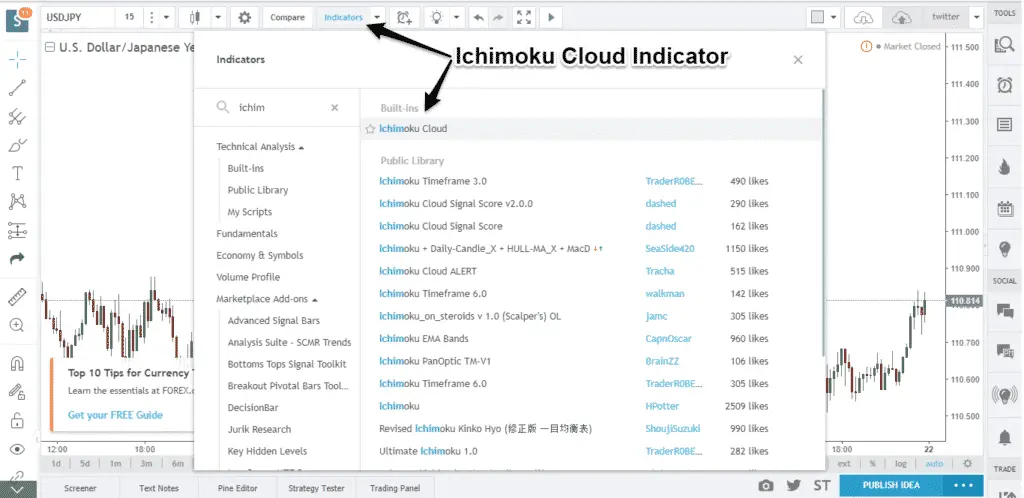
In the Ichimoku cloud section, we are going to give you an in-depth overview of the Ichimoku components.
So, before moving forward, let’s define all the Ichimoku Cloud components. We will review how to correctly interpret the trade signals generated by this technical indicator.
Ichimoku Cloud Explained
The Ichimoku Hinko Hyo is a momentum indicator used to recognize the direction of the trend. It can also define accurate support and resistance levels. The Ichimoku Cloud indicator consists of five main components that provide you with reliable trade signals:
- Tenkan-Sen line also called the Conversion Line, represents the midpoint of the last 9 candlesticks. It’s calculated with the following Ichimoku formula: [(9-period high + 9-period low)/2].
- Kijun-Sen line also called the Base Line, represents the midpoint of the last 26 candlesticks. It’s calculated with the following formula: [(26-period high + 26-period low)/2].
- Chiou Span also called the Lagging Span, lags behind the price (as the name suggests). The Lagging Span is plotted 26 periods back.
- Senkou Span A also called the Leading Span A, represents one of the two Cloud boundaries and it’s the midpoint between the Conversion Line and the Base Line: [(Conversion Line + Base Line)/2]. This value is plotted 26 periods into the future and it’s the faster Cloud boundary.
- Senkou Span B or the Leading Span B, represents the second Cloud boundaries and it’s the midpoint of the last 52 price bars: [(52-period high + 52-period low)/2]. This value is plotted 52 periods into the future and it’s the slower Cloud boundary.
- Chikou Span represents the closing price and is plotted 26 days back.
Next…
We’ll outline how to master the Ichimoku cloud trading.
See below:
How to use Ichimoku Cloud Indicator in Trading? Best Ichimoku Strategy
While the Ichimoku Cloud indicator involves multiple (five) different lines, reading the graph is actually very easy. Using the trend lines mentioned above, you will then need to determine whether Leading Span A or Leading Span B is currently higher.
Once Leading Span A and Leading Span B have been identified, the “cloud” component of this graph will be shaded in. When Leading Span B is above Leading Span A, this indicates to traders that price momentum is currently increasing. When this is the case, the graph will be shaded green.
On the other hand, when Leading Span A is above Leading Span B, the underlying asset is likely moving in a negative direction. When this happens, the cloud will be shaded red. Despite the graph’s complications, simply looking at the colors of the cloud can help you determine the direction of the market.
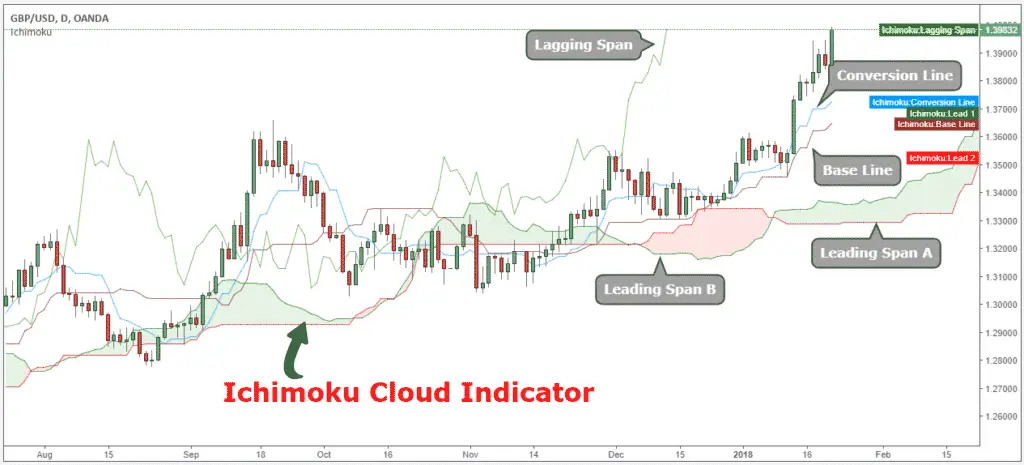
Here are some basic interpretations of the Ichimoku charts:
- When the price is above the Cloud, we’re in a bullish trend.
- When the price is below the Cloud, we’re in a bearish trend.
- When the price is in the middle of the cloud the trend is consolidating or ranging.
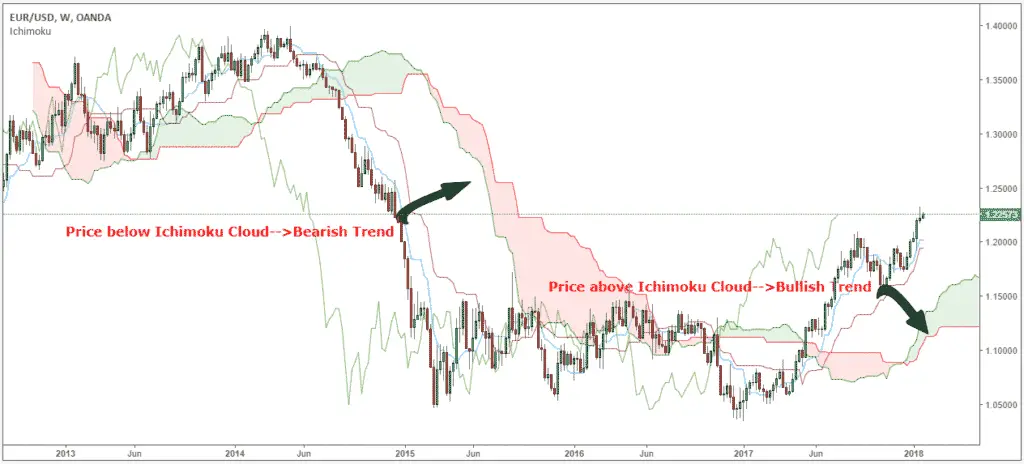
Furthermore, the Ichimoku charting technique provides bullish and bearish signals of various strengths.
When the Tenkan crosses Kijun from below, it is considered a bullish signal. When the Taken crosses the Kijun from above, it is considered a bearish signal. The Kijun line is shown as the red line above.
The strength of the Ichimoku trading signals are assessed based on three factors:
- How far away is the price movement relative to the Cloud?
- How far away is the Chiou Span relative to the Cloud?
- How far away is the Cross-over relative to the Cloud?
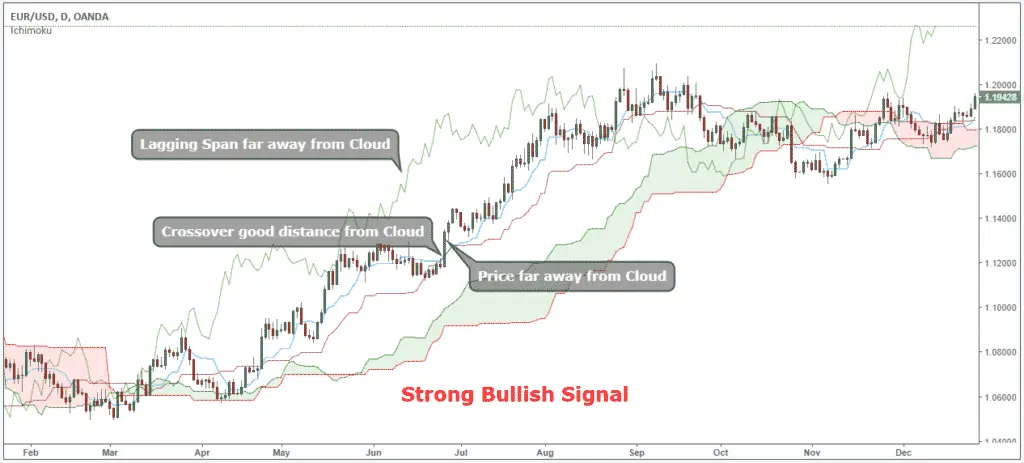
Because many of the lines on the Ichimoku Cloud chart are created using averages, the chart is often compared to a simple moving average chart. However, Ichimoku is more dynamic than a simple moving average chart as it’s designed to help detect changes in support and resistance.
The relationship between Leading Span A and Leading Span B will indicate whether there is a strong downtrend or uptrend. Pay attention to both the color (green for bullish, red for bearish) and the size of the cloud. When the “cloud” between these lines is small, then the trend will not be very strong.
The Ichimoku Cloud is useful for day traders and others who need to make quick decisions. The cloud is often paired with other technical indicators, such as the Relative Strength Index, in order for traders to get a complete picture of resistance and support. Many traders will also look out for crossovers in order to determine when trends have reversed.
Ichimoku cloud trading requires a lot of self-discipline. This is because you have to wait for the best trade signals. We’re going to use the default settings of the Ichimoku Cloud system.
Next…
Let’s see a unique way day traders can take advantage of a very unique price pattern:
See below:
How to Use Ichimoku Cloud for Day Trading Best Ichimoku Strategy
The best Ichimoku cloud day trading technique is the edge-to-edge cloud setup.
According to the Ichimoku cloud edge-to-edge strategy, the price has the tendency to visit the other side of the Kumo cloud once a candlestick closes inside the Ichimoku cloud.
As you can figure out the Ichimoku buy sell signals are very intuitive:
- Buy signals occur when a candlestick from below the Kumo cloud breaks and closes above the Leading span A.
- See signals occur when a candlestick from above the Kumo cloud breaks and closes below the Leading span A.
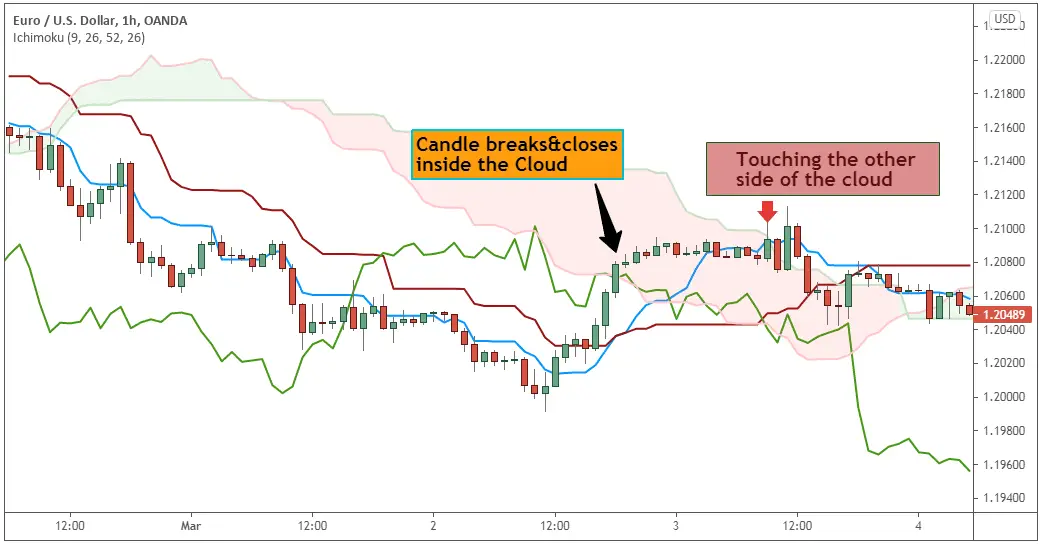
On a day-to-day basis, you’ll have enough edge-to-edge trade signals to reach your profit goals.
Now, if you want to improve the stats of the Ichimoku cloud day trading strategy you can always use the other elements of the Ichimoku indicator to filter out some of the false signals that will naturally show up.
Next…
Let’s see how to trade the Ichimoku indicator if you’re a swing trader.
See below:
How to Use Ichimoku cloud for Swing Trading Best Ichimoku Strategy
Swing trading with Ichimoku Cloud works extremely well if you use the Kumo twist trade signal. Please note that the Kumo cloud is the leading element (projected 26-periods into the future) of the Ichimoku indicator.
Now:
You might wonder:
“What is a Kumo twist?”
The Kumo cloud twist happens when the Leading Span A and Leading Span B cross. When Leading Span A crosses above Leading Span B that’s a bullish reversal signal and when Leading Span A crosses below Leading Span B that’s considered to be a bearish reversal signal.
See the Ichimoku chart below:
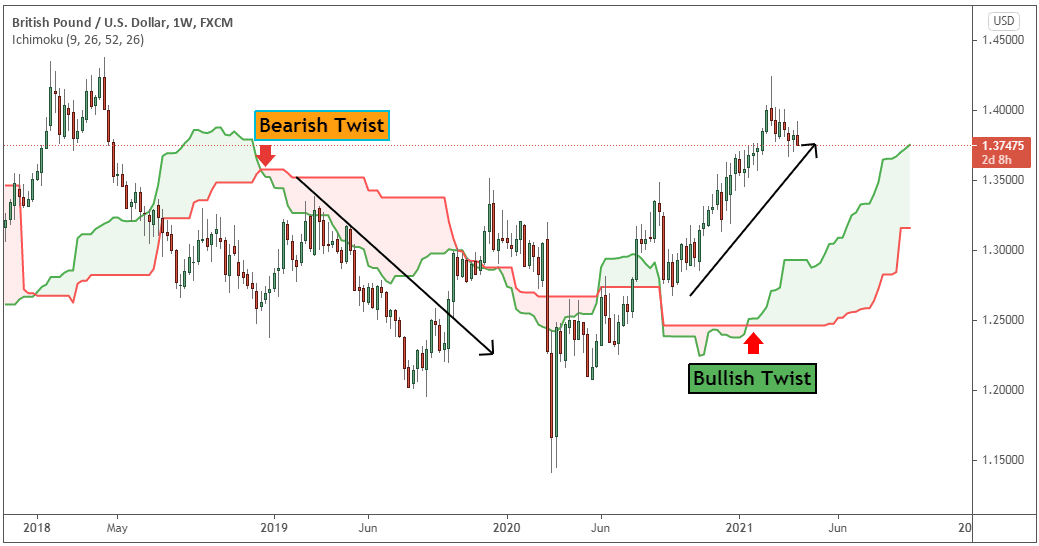
Note* The cloud will switch colors from green to red and vice-versa when the Kumo twist happens.
Now, let’s move one step forward and learn how to make money by applying the Ichimoku trading rules.
Note* Moving forward, we’re not going to delete the Lagging Span moving average from our charts. This is because we don’t base our trade decision on it since it’s lagging the price.
The Best Ichimoku Strategy – Buy Rules
The Ichimoku Cloud system is designed to keep traders on the right side of the market. Our trading rules will help you follow the trend for as long as possible. At least until it’s clear that a reversal is occurring. The Ichimoku system suits swing trading best. This is because it maximizes profits while minimizing the risk involved in trading. Here is how to identify the right swing to boost your profit.
The Ichimoku Kinko Hyo best time frame is the one that fits you best. As we don’t have a preferred time frame.
This swing trading strategy will teach you how to ride the trend right from the beginning. You will also learn how to capture as many profits as possible.
Ichimoku Cloud Trading: Step by Step Best Ichimoku Strategy
Step #1 Wait for the Price to Break and close above the Ichimoku Cloud.
Ichimoku cloud trading requires the price to trade above the Cloud. This is because it’s a bullish signal and potentially the beginning of a new up-trend.
The cloud is built to highlight support and resistance levels. It highlights several layers deep because support and resistance is not a single line drawn in the sand. It is several layers deep.
So, when we break above or below the Ichimoku Cloud, it signals a deep shift in the market sentiment.
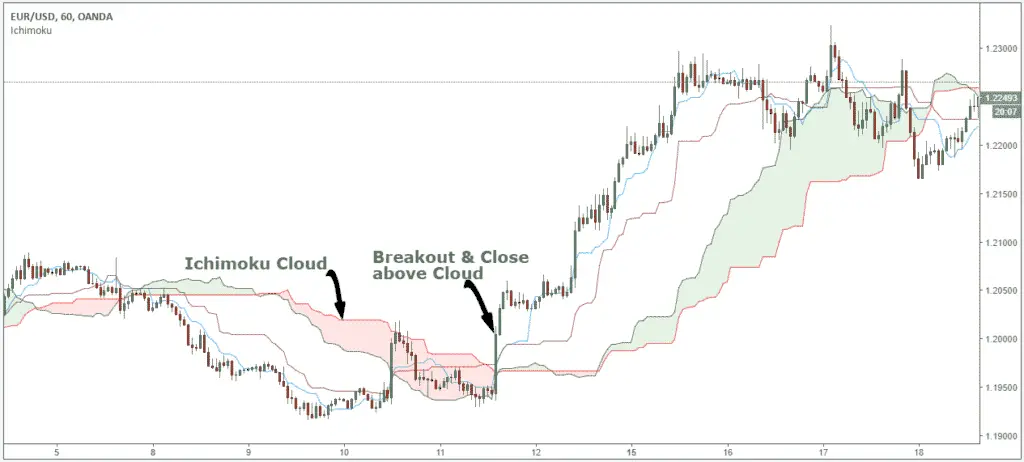
A high probability trade setup requires more layers of confluence before pulling the trigger.
This brings us to our next requirement for a high probability trade setup.
Step #2 Wait for the Crossover: The Conversion Line needs to break above the Base Line.
The price breakout above the Cloud needs to be followed by the crossover of the Conversion Line above the Base Line. Once these two conditions are fulfilled, we can look to enter a trade.
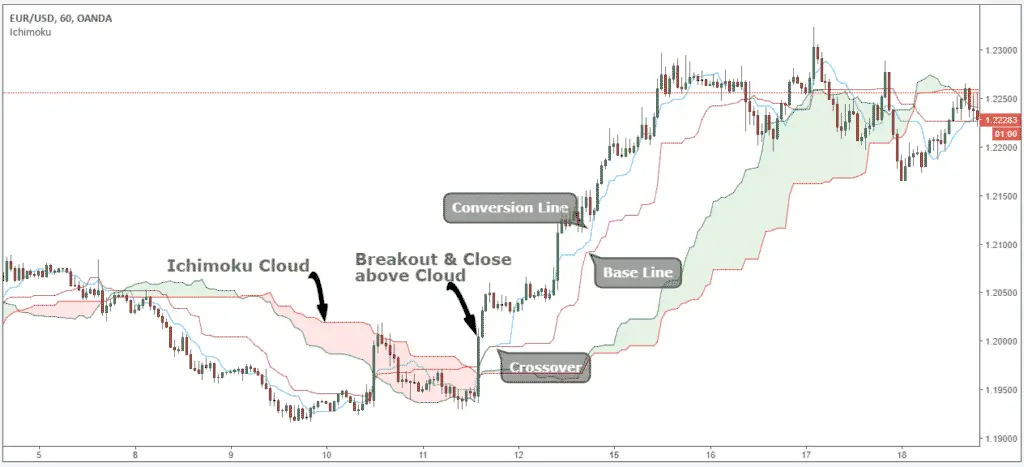
The Ichimoku Cloud indicator is a very complex technical indicator. The indicator is even used as a moving average crossover strategy.
Now, we’re going to lay down a very simple entry technique for the Ichimoku Kinko Hyo trading system.
See below….
Step #3 Buy after the crossover at the opening of the next candle.
Ideally, any long trades using the Ichimoku strategy are taken when the price is trading above the Cloud. Our team at the TSG website has adopted a more conservative approach. We added an extra factor of confluence before pulling the trigger on a trade.
So, after the crossover, we buy at the opening of the next candle.
(Notice the strong buy signal in the graph below.)

The next important thing we need to establish is where to place our protective stop loss.
See below…
Step #4 Place protective stop loss below the breakout candle.
The ideal location to hide our protective stop loss is below the low of the breakout candle. This trading technique accomplishes two major things. Here is an example of a master candle setup.
First, it’s significantly lowering the risk of losing big money. Second, it helps us trade with the market order flow.

Since this is a swing trading strategy, we’re looking to capture as much as possible from this presumably new trend. We’ll be looking to trail our stop loss level below the Cloud or exit the position once a new crossover happens in the opposite direction.
The next logical thing we need to establish for the Ichimoku trading system is where to take profits.
See below…
Step #5 Take Profit when the Conversion Line crosses below the Base Line.
We only need one simple condition to be satisfied with our take profit strategy.
When the conversion line crosses below the baseline we want to take profits and exit our trade.
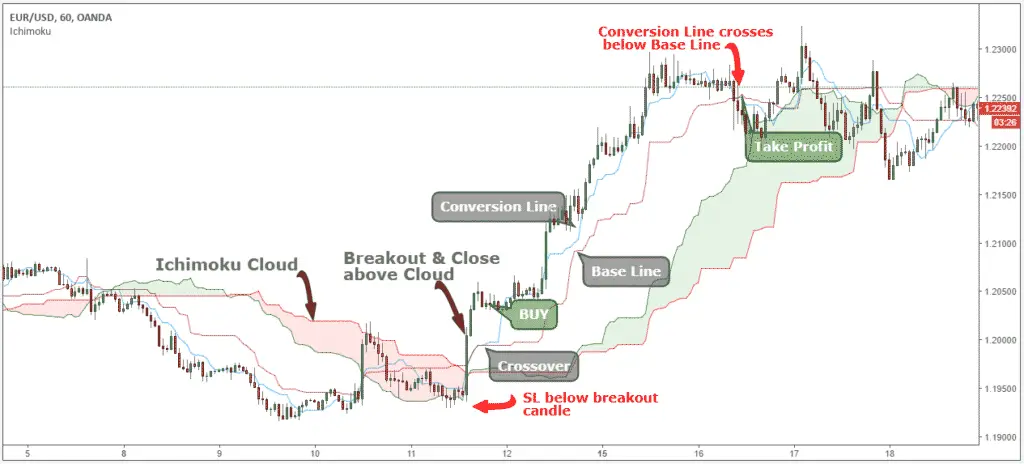
Alternatively, you can wait until the price breaks below the Cloud, but this means risking to lose some parts of your profits. In order to gain more, sometimes you have to be willing to lose some.
Note** the above was an example of a BUY trade using the advanced Ichimoku trading strategies. Use the same rules for a SELL trade – but in reverse. In the figure below, you can see an actual SELL trade example.
(See the strong sell signal in the conversion line.)
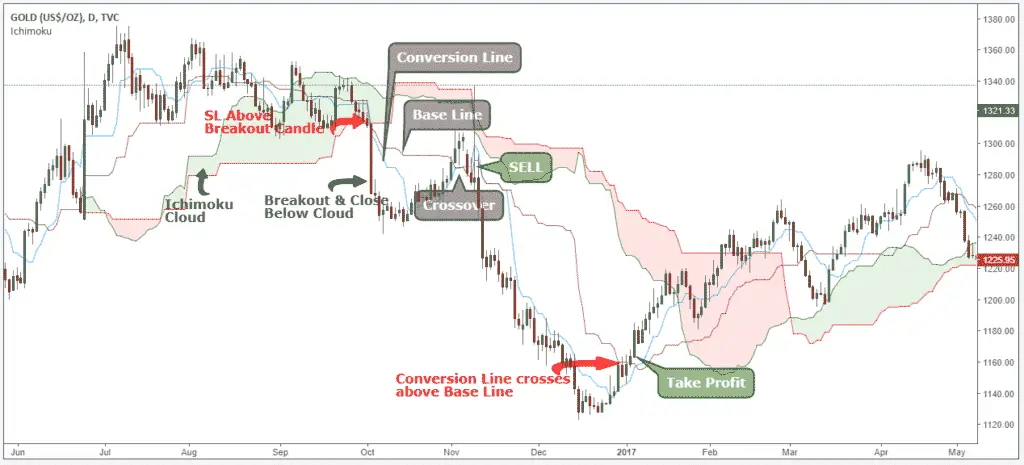
Frequently Asked Questions for the Ichimoku Trading System Best Ichimoku Strategy
We have complied a list of the most common questions for the best Ichimoku strategy, so that you can easily apply these tips to your trading arsenal. Best Ichimoku Strategy is one of our favorite strategies.
Can I use use Ichimoku cloud for day trading?
Yes, the Ichimoku Cloud can be used for day trading to identify trends and potential trading opportunities.
There are two ways to use the Ichimoku Cloud for day trading:
1.Identify potential entry and exit points based on the cloud’s upper and lower boundaries.
2. Use the Tenkan-sen and Kijun-sen lines as dynamic support and resistance levels to make trading decisions.
What are the best Ichimoku settings for scalping?
You can use the Ichimoku cloud trading strategy for scalping and for the 1-minute chart however there are no best settings. The important thing to remember is that you should keep winners larger than your losers. For example if you risk $1 on the trade you should make $2 or more on each position.
Do you have a Ichimoku strategy pdf for Download?
Yes! we have found that keeping the best Ichimoku Strategy PDF is a great way to learn the strategy. We sometimes print it and keep it right next to our desk when trading so we can reference it quickly. You can grab this here for free.
How to Use the Ichimoku Cloud?
Ichimoku Cloud is a technical tool used in trading. It identifies trends, support and resistance levels, and entry and exit points. Use the cloud’s upper and lower boundaries and Tenkan-sen and Kijun-sen lines as dynamic support and resistance levels.
Here is the 4 step quick reference guide:
1. Identify the trend direction: The Ichimoku Cloud provides a visual representation of the trend direction by plotting a cloud that consists of two lines, namely the Senkou Span A and Senkou Span B. If the cloud is green, it indicates an uptrend, while a red cloud represents a downtrend.
2.Look for support and resistance levels: The Ichimoku Cloud can also help identify key support and resistance levels. The Tenkan-sen and Kijun-sen lines can act as dynamic support and resistance levels, while the cloud’s upper and lower boundaries can act as static support and resistance levels.
3. Confirm signals with other indicators: Traders can use other technical indicators such as the Relative Strength Index (RSI) or Moving Average Convergence Divergence (MACD) to confirm signals generated by the Ichimoku Cloud.
4. Set stop-loss orders: Traders should always set stop-loss orders to minimize potential losses in case the market moves against their position.
Final Thoughts: Ichimoku Cloud Explained Best Ichimoku Strategy
The best Ichimoku strategy is slightly different than probably anything you’re used to when it comes down to technical analysis. If you’re having a very difficult time finding true support and resistance, please apply the Ichimoku cloud trading techniques highlighted in this course.
Swing Trading ReportGet Our Free Swing Trading Strategy
Get Our Free Swing Trading Report Today!
- Entry Points
- Exit Points
- Risk Managament
- Time Saving Tips
We hope that by now you’re convinced that the Ichimoku Cloud system is a good way of identifying the trends and profit from trading any market in any time frame. It can easily capture 80% of the trend if you follow the rules in the Ichimoku Cloud explained section.
Thank you for reading! Best Ichimoku Strategy.
Please leave a comment below if you have any questions about Best Ichimoku Strategy!
Also, please give this strategy a 5 star if you enjoyed it!
Here is a video on Ichimoku taught by Tim Black!
Please Share this Trading Strategy Below and keep it for your own personal use! Thanks, Traders!




